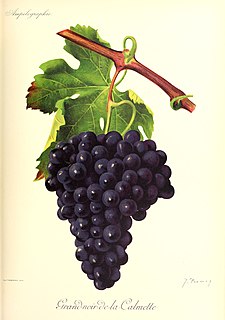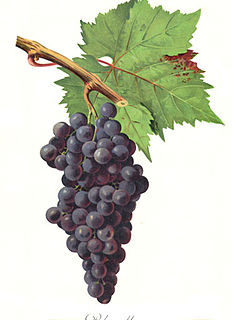
Carignan is a red grape variety of Spanish origin that is more commonly found in French wine but is widely planted throughout the western Mediterranean and around the globe. Along with Aramon, it was considered one of the main grapes responsible for France's wine lake and was a substantial producer in jug wine production in California's Central Valley but in recent years, it has been reborn as a flagship wine for many cellars in the south of France as well as in Catalonia.

Folle blanche, also known as Picpoule, Gros Plant, and Enrageat blanc, is a wine grape variety from southwest France. It was the traditional grape variety in Cognac and Armagnac production until the 20th century. Folle blanche is an offspring of Gouais blanc, with the other parent so far unidentified.

Mondeuse noire is a red French wine grape variety that is grown primarily in the Savoy region of eastern France. The grape can also be found in Argentina, Australia, California, Switzerland and Sicily. Plantings of Mondeuse noire was hit hard during the phylloxera epidemic of the mid to late 19th century which nearly wiped out the vine from eastern France. While the grape recovered slightly in the 20th century, French plantations of Mondeuse noire fell sharply in the 1970s, with just over 200 hectares left in France in 2000. In the early 21st century, it seems the variety has increased somewhat in popularity, as it can give good wines if the planting site is chosen carefully.

Grand Noir de la Calmette is a red teinturier grape variety that is a crossing of Petit Bouschet and Aramon noir created in 1855 by French grape breeder Henri Bouschet at his vineyard in Mauguio in the Hérault department. The grape was named after the breeding station Domaine de la Calmette. As a teinturier, Grand noir is often used to add color to wines that it is blended into but is paler than other choices such as Alicante Bouschet. The vine tends to bud late and has a high productivity but with some susceptibility to the viticultural hazard of powdery mildew.

Béarn is an Appellation d'Origine Contrôlée (AOC) for wine in South West France. It is located in the area of intersection of three French departments: Pyrénées-Atlantiques, Hautes-Pyrénées and Gers; and two regions: Aquitaine and Midi-Pyrénées. Some vineyards in the area of the Jurançon AOC can also produce red Béarn wine, and some in the area of the Madiran AOC may produce a rosé Béarn. Wines made in the village of Bellocq also carry the appellation Béarn-Bellocq.

Calitor or Calitor noir is a red French wine grape variety. It was previously widely cultivated in southern France, in particular in Provence, but is now very rare, almost extinct. Historically used as mainly a blending variety, Calitor gives high yields and produces a light-bodied and lightly colored wine. When grown on hillside sites, it can give a wine of character.
Camaralet is a white French wine grape variety that is grown primarily in Southwest France. While historically known for its strong aromatics and flavor profile, the grape has been declining in importance and planting and is now nearly extinct.

Persan is a red French wine grape variety that is grown primarily in the Savoie region. While the name hints at a Persian origins for the grape, it is most likely native to the Rhône-Alpes region with the name "Persan" being a corruption of the synonym "Princens" which is also the name of a small hamlet by Saint-Jean-de-Maurienne in Savoie which has been noted since the 17th century for the quality of its vineyards.
Wine Grapes - A complete guide to 1,368 vine varieties, including their origins and flavours is a reference book about varieties of wine grapes. The book covers all grape varieties that were known to produce commercial quantities of wine at the time of writing, which meant 1,368 of the known 10,000 varieties. It is written by British Masters of Wine Jancis Robinson and Julia Harding in collaboration with Swiss grape geneticist Dr. José Vouillamoz.
Enfariné noir is a red French wine grape variety that is grown predominantly in the Jura wine region of eastern France. Despite being known under the synonym Gouais noir in the Aisne, Aube, Marne, Meuse and Seine-et-Marne departments, the grape has no known connection to the Gouais blanc wine grape that is the parent of several wine grape varieties such as Chardonnay, Gamay and Melon de Bourgogne. While once widely planted throughout the Franche-Comté, the grape is now nearly extinct with less than 1 hectare of the variety planted in 2008.
Béquignol noir is a red French wine grape variety that originated in Southwest France but is now more widely grown in the Mendoza wine region of Argentina where it is often used to add color to blends. The grape is often confused with several other red wine varieties such as Cabernet Franc, Durif, Fer and Prunelard with Béquignol noir sharing several synonyms with these grapes. However DNA profiling has shown Béquignol noir to be distinct from those grape varieties. Further research in 2011 showed that Béquignol noir may have a parent-offspring relationship with the Savagnin grape.
Balzac blanc is a white French wine grape variety that is grown in the Charente and Charente-Maritime regions of Southwest France where it was once used for Cognac production but now is nearly extinct. The grape was one thought to be a color mutation of Mourvèdre but DNA analysis in 2000 showed that the two grapes were distinct and that Balzac blanc was a crossing of Gouais blanc and Chenin blanc.
Bouteillan noir is a red French wine grape variety that is grown in the Provence wine region of southern France. While the grape has been recorded growing in the Vaucluse region since at least the early 18th century, today the grape is virtually extinct. Despite sharing synonyms with another Provençal grape, Calitor, and the Languedoc wine grape Aramon noir, Bouteillan noir has no known relationship with either of those variety. The white Provençal grape Colombaud was once thought to be a white berried color mutation of Bouteillan noir but research conducted by Dr. Linda Bisson of the University of California, Davis shows that while the two grapes are likely related, one is not a color mutation of the other.
Canari noir is a red French wine grape variety that has been historically grown in the Ariège department in the foothills of the French Pyrénées. However DNA profiling in 2001 showed that plantings of a grape called Gamay Luverdon growing in the Italian wine region of Piedmont were in fact plantings of Canari noir. Across the Pyrénées in Spain, the grape variety known as Batista was also found to be identical to Canari noir. Like Pinot noir and Grenache, Canari noir has color mutations known as Canari blanc and Canari gris.
Gueuche noir is a red French wine grape variety that has been historically grown in the Franche-Comté of eastern France but is now close to being extinct. Though its exact relationship has not yet been determined by DNA analysis, ampelographers believe that the grape variety is closely related to the Hunnic grape Gouais blanc which is notable for being the mother vine to several grape varieties including Chardonnay and Gamay. There also might be a relationship between Gueuche noir and the Jura wine grape Enfariné noir.
Mauzac noir is a red French wine grape variety that is grown in Southwest France. Despite the similarities in name, Mauzac noir is not a color mutation of the white Limoux wine grape Mauzac that is an important component in the Appellation d'origine contrôlée (AOC) sparkling wine Blanquette de Limoux. Today Mauzac noir is nearly extinct but at least one grower in the Gaillac AOC is attempting to revive the variety and make varietal examples of the grape.
Mornen noir is a red French wine grape variety that was historically grown in both the Rhône and Loire departments but is today only found in very limited plantings around the commune of Chavanay. It was thought that the grape was also to be found growing in Hungary under the names Kékmedoc and Medoc noir, but DNA analysis has confirmed that the Hungarian plantings are actually a separate variety now known as Menoir
Arrouya noir is a red French wine grape variety grown in the Jurançon region of Southwest France. The grape has a long history in the region, growing in the Pyrénées-Atlantiques since at least the late 18th century. Ampelographers believe that Arrouya noir has some genetic relationship with Camaraou noir, Fer and Petit Courbu though the exact nature of those relationships is not yet known. The variety also shares some similarities in morphology with Cabernet Franc and until the late 19th century was often confused for the Loire and Bordeaux wine grape, especially in the Basses-Pyrénées and Hautes-Pyrénées region.
Caíño blanco or Cainho branco is a white Spanish and Portuguese wine grape variety that is grown in northwest Spain and northern Portugal in a stretch of area between Vinho Verde and the Denominación de Origen (DO) of Rías Baixas. The grape is often confused for Albariño and in Vinho Verde it is sometimes known under the name Alvarinhão. While DNA profiling conducted in the early 21st century has shown that the two grapes are distinct varieties, the evidence has suggested that Caíño blanco maybe an offspring of Albariño from a natural crossing with the red Portuguese wine grape Azal tinto.
Bariadorgia is a white Italian/French wine grape variety that likely originated on the island of Sardinia but today is only found in limited planting on Corsica. Despite similarities in synonyms, Bariadorgia/Carcajolo blanc is not a color mutation of the red Spanish wine grape Parraleta which is also known as Carcajolo near on Sardinia.








